How to connect a heated floor with your own hands: stages of connecting a water floor
Water-based heated floors, along with electric ones, are increasingly being used in the heating system of private homes.Indeed, a children’s room or bathroom with “bottom” heating is much more comfortable.
Unlike electrical systems, water systems are considered less expensive if the heating of the coolant in the pipes is provided by a gas boiler - part of the overall heating system. But they are more difficult to install and manage, so before implementing a project to install underfloor heating, you need to study many technical nuances.
In this article we will talk about how to connect a heated floor with minimal losses and without serious technical errors. We offer clear step-by-step instructions with which you will select the necessary materials, understand the key principles of pipe laying and ultimately solve the heating problem in your own home.
The content of the article:
Important factors when installing heated floors
Before moving on to the installation instructions, we will consider a number of factors, without taking into account which it is impossible to start designing a heating system with heated floors.
Owners of private houses have more options when choosing a heating system: they are autonomous and independent of the centralized water supply. Owners of apartments in multi-storey buildings most often do not have the chance to install water-type heated floors - only electric ones.
The following requirements apply to rooms where a water system is planned:
In general, by the time the heating system is connected, it is necessary to reduce heat loss as much as possible, that is, insulate the house, otherwise both warm floors and radiator heating will be ineffective.
Be prepared for the fact that purchasing components and implementing the project will be expensive. Installation of equipment consists of several stages, which we do not recommend neglecting. But there is also a big plus: after a couple of years, installing a heated floor will pay off with interest if choose a boiler, running on natural gas.
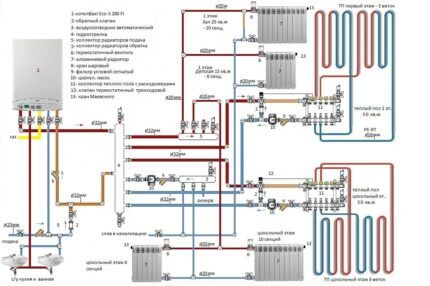
There are two options for installing heated floors - “wet” and “dry”. The first one differs in that it involves pouring a cement-sand screed and requires more time for installation, but it is the one that is chosen more often. The second one is advisable to implement if it is planned to lay wooden floors as a finishing coating.
The best floor covering for installing heated floors is considered ceramic tiles, but laminate is more often used, linoleum or carpet with a special mark.
Step-by-step installation instructions
We offer instructions that include 8 steps. Each of them is important in its own way, and if one is excluded, then failures may occur during the operation of the system.
Repairing a water heated floor is an expensive, time-consuming and very troublesome task, so from the very beginning you need to carefully and meticulously approach the arrangement of the system.
Now we will analyze each stage in detail - from the purchase of components to the final connection. Our recommendations should not be taken as the only possible ones - there are many interesting and effective solutions.
We recommend that you take the proposed instructions as general rules that should be followed during preparation and installation. The individual details and nuances of the device largely depend on the specific project.
Step #1 - design and selection of installation scheme
You can plan the work in different ways: contact a company engaged in similar projects, or do everything yourself. But in order to make calculations and bring the idea to life on your own, you need at least an engineering education, sufficient experience and knowledge of computer programs. Otherwise, a successful result is not guaranteed.
Here are a few points you need to know when drawing up a project:
- the average comfortable floor temperature in living rooms and bedrooms is 21-27 °C;
- for bathrooms, toilets and combined bathrooms, the parameters are higher - 31-32 °C;
- coolant with a temperature of no higher than 60 °C is supplied to the heating circuits of the floor (for comparison, to radiators - up to 90 °C);
- temperature drop in the underfloor heating pipeline, that is, the difference between the supply and outlet is 10 degrees;
- the diameter of the pipe depends on the length of the circuit: Ø 16 mm – 80-90 m, Ø 17 mm – 90-100 m, Ø 20 mm – up to 120 m.
Ideally, all water circuits should be the same length - this makes balancing easier. But in practice this is almost impossible, so you need to maintain at least the same diameter for all pipes.
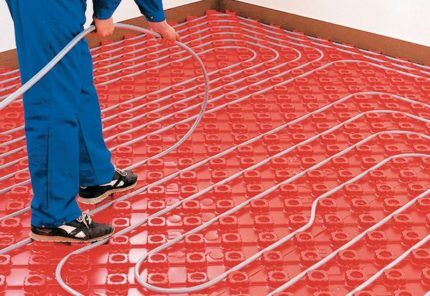
Near the outer walls there are so-called "cold zones", therefore, the laying step is no more than 150 mm, in the center - 250-300 mm. If there are no external walls, then throughout the room you can maintain an interval of 200-300 mm.
In swimming pools, bathrooms, baths, the floor should be as warm as possible, so the layout step is 100-150 mm. It will not be possible to make a smaller interval without kinks in the pipeline.
There are two main methods used to lay out contours: "snake" And "snail". “Snake” is easier to install, but produces a large temperature difference at the inlet and outlet – up to 10 degrees. It is good to use in areas with external walls. “Snail” is more difficult to implement, but thanks to this layout, temperature stability is maintained throughout the entire circuit.
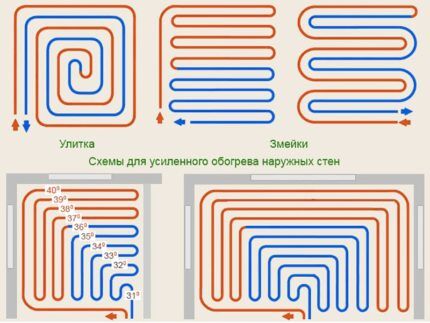
Combination options are often used, combining different methods in one room. If you calculate it correctly, the heating will be as efficient as possible.
It is recommended to use a separate circuit for each room. The only exceptions are small, adjacent rooms - for example, a toilet and a bathroom.
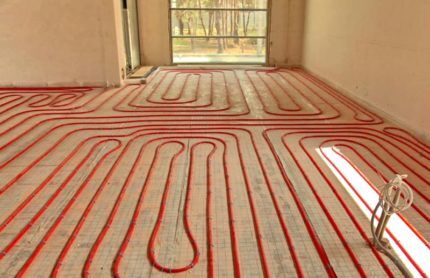
It should be taken into account that thermal expansion occurs when heated. It is compensated for by a damper tape, which is laid between the contours, adjacent rooms and along all walls.
We talked more about installation and connection schemes in our other article.To view this information, please go to link.
Step #2 - preparing materials
Get ready for the fact that the design of a heated floor consists of a large number of parts, and you need to select only high-quality products that best suit each other. Let's consider the most significant of them: pipes, insulation and collector.
For heating circuits, pipes made from cross-linked polyethylene with PEX or PERT marking:
- PEX – characterized by a “memory effect”, have an 85% cross-linking density, and are connected by axial fittings that can be filled with screed;
- PERT - do not have a memory effect and are connected with collet-type fittings, which cannot be filled with cement, but can be used in open areas - for example, in manifold connections.
In practice, both types of pipes are used.
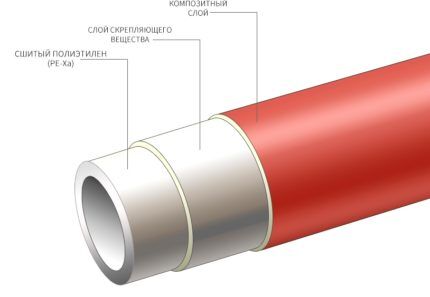
For home use, pipelines with Ø 16 or 20 mm are most often used. We also recommend that you read the rules pipe calculations for heated floors.
We recommend not to buy cheap, dubious analogues, but to choose products from one of the trusted manufacturers: Valtec, Rehau, KAN, Tece or Uponor. Do not forget that the service life of the heated floor depends on the quality of the components.
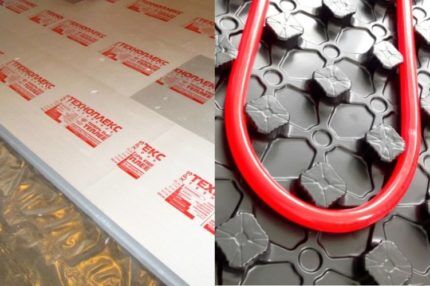
EPPS is durable, moisture resistant, has low thermal conductivity, and has an affordable price.Plates of different sizes are connected to each other using grooves.
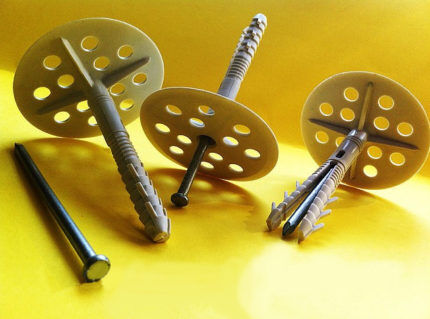
Profile mats made from dense polystyrene foam. They are covered with bulges on top, allowing heating circuits to be laid evenly and in size. Mats are more expensive than EPS boards, and they are usually purchased if financial capabilities allow.
The collector is responsible for distributing the coolant along the circuits, adjusting and balancing. This is a complex assembly consisting of a large number of parts, including:
- the collectors themselves with balancing valves and shut-off valves;
- air vents operating in automatic mode;
- connecting fittings;
- drain taps;
- brackets for fixation.
If there is no separate riser, you will need mixing unit, consisting of a bypass, pump and thermostatic valve.
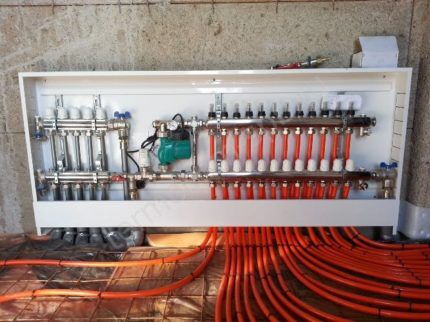
There is no specific place for installing a manifold cabinet - it could be a corridor, a dressing room, an entrance hall, a separate small room or a specially designed niche.
Step #3 - installation of insulation
We skip all types of rough work - creating a niche for a manifold cabinet or additional passages in building structures, and go straight to the installation of the heat-insulating layer. Before doing this, the base needs to be cleaned and leveled.
The procedure for laying EPS boards:
- We mark the level of the finished floor and mark it with marks on the walls.
- We fill the uneven areas with sand.
- We lay the slabs, connecting them with grooves, starting from the far wall, or better yet, the corner.
- The joints of adjacent slabs should not coincide, so we lay them offset.
- If the installation of the second layer is planned, we also lay the slabs without matching seams.
- We fix the slabs with disc dowels using a hammer drill or hammer.
- We glue the joints and seams with construction tape, leaving no gaps.
Large gaps can be filled with small remnants of slabs, and blown out with polyurethane foam on top.
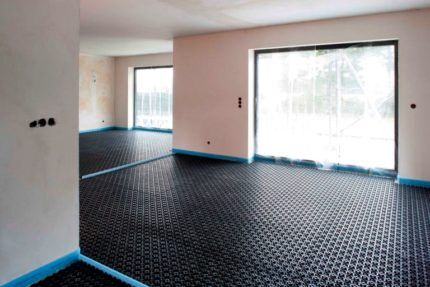
If heated floors are located above the ground floor, basement or on the ground, first cover the base with a waterproofing film - polyethylene or a 150-200 micron membrane. Roll out the rolls with an overlap of about 100 mm, seal all seams with tape.
We discussed in detail the features of laying various types of insulation in next article.
Step #4 - fixing the water pipe
Before laying the circuits, you need to install a manifold cabinet, and then start work from the most distant point. Transit pipes running from the collector to their destination are masked in a thermal insulation layer and additionally placed in covers made of foamed polyethylene to retain heat.
At the same stage, we fix the damper tape around the perimeter with liquid nails.

Circuit installation procedure:
- We unwind 12-15 m of pipe from the coil, put on insulation and a manifold fitting.
- We connect the insulated end to the collector.
- Without effort or tension, we lay the pipeline along the intended contours, secure it with brackets after 35-40 cm (at turns - after 10 cm).
- Having bypassed the circuit, we bring the return pipe to the supply pipe, we also put corrugation or thermal insulation on the second end, and connect it to the manifold using a fitting.
- We record the length of the circuit opposite the corresponding input/output on the collector.
We also connect the remaining loops of the pipeline. If during installation the staples fly out, repeat the fixation, but not in the same place, but at a distance of at least 5 cm from it.
To avoid damaging the insulation or pipes, we use flooring made from sheets of plywood or pieces of chipboard to move around work areas.
Step #5 - laying the reinforcing mesh
A mesh made of metal wire or plastic is placed not under the pipe, but above it. Plastic rolled mesh is cheaper, lighter and more convenient to install.
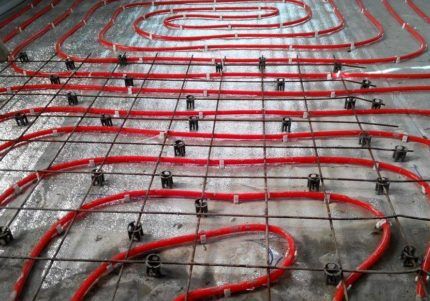
Pieces of mesh are placed overlapping 1-2 cells, connected to each other with plastic ties or wire, and the protruding ends are removed.
Step #6 - hydraulic tests
Everything is ready to pour the screed, but before that you must check the operation of the system. Water is connected to the supply manifold, and a hose is connected to the outlet, leading it to the sewer.
A pressure testing pump is installed on the line to one of the outlets.
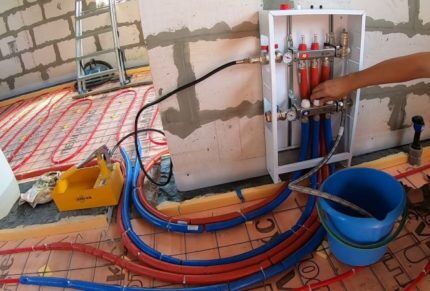
Procedure for filling the circuits with water:
- we block all collector circuits except the one being tested;
- supply clean water from the tap;
- monitor the air outlet until clean water flows without air bubbles;
- overlap the filled contour, move on to the next one - and so on with everyone;
- turn off the water supply and turn on the valve.
After this, you need to carry out tests using a special pump - a pressure test. We recommend involving an experienced professional who is familiar with the process for the procedure.
The essence of the tests: water is supplied to the system at a pressure higher than the working one - about 6 atmospheres. After this, check the pipes for leaks, then release the pressure, and repeat this at least 3 times. Then the circuits are left at high pressure for a day. If after 24 hours there are no leaks, the system is sealed and installed without flaws.
Step #7 - installing beacons and pouring screed
Before screeding, the pipes must be filled with water and the operating pressure must be set to an average of 2 bar. Then we install beacons.
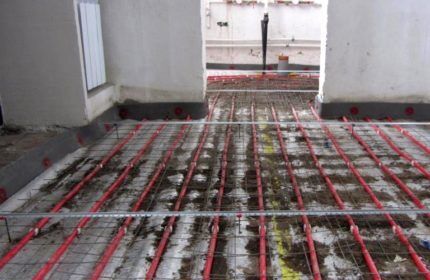
The distance from the outermost beacon to the wall is 0.3 m, between the beacons – no more than 1.5 m. Accordingly, the length of the leveling rule is 2 m.
After this, prepare the screed solution. The ideal option is a regular mixture, but with the addition of plasticizers. The fact is that in addition to mechanical load, the screed will constantly experience temperature changes, so it must be plastic and movable.
We recommend purchasing special plasticizers or fiber, which are sold in a large assortment. It is better to avoid alternative grandma's recipes in the form of adding PVA glue or liquid soap.
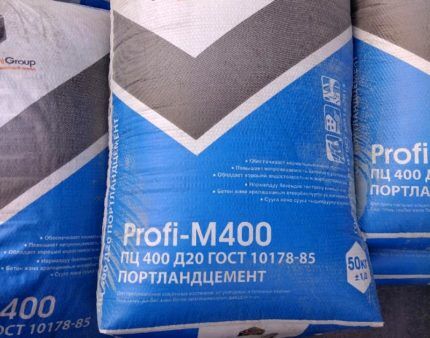
For every 50 kg bag there is about a bucket of water. It is better to add liquid gradually, because plasticizers change the composition.
The procedure for pouring the screed:
- We remove unnecessary items from the floor and close the windows.
- We prepare a high-quality solution, better with a construction mixer than with a drill.
- We begin laying the screed from the farthest point, in strips, guided by the beacons.
- We make adjustments and leveling of the surface after filling each strip between the beacons.
- After a couple of days, after drying, we clean out the unevenness and remove the layer of cement to the beacons.
- We moisten the screed and cover the floor with polyethylene.
Another day later, we remove the beacons, mask the resulting cracks, and once again spray water on the concrete surface. It is recommended to moisturize for at least 10 days.
Step #8 - commissioning
The maturation of the screed takes about a month, and only after that can we begin balancing, which is necessary to equalize the parameters of the coolant in the circuits. This is done using manifold flow meters.
First, set the normal operating pressure (from 1 to 3 bar), then take readings from the flow meter of the longest loop and adjust the remaining loops according to the measured parameters, one by one, in order of decreasing length.
After balancing, the temperature in the system is gradually increased, starting from 25 ° C and increasing to 40-45 ° C, adding 5 degrees daily.
At first, it is recommended to carefully observe the “behavior” of the heated floor, monitor changes in the thermal regime and, if necessary, repeat the adjustment.
Conclusions and useful video on the topic
What the process and result of installing a heated floor looks like + overview of the collector unit:
What mistakes should you avoid:
More information about the dimensions of the contours and the nuances of pipe laying:
Tips based on personal experience:
According to statistics, heating systems with properly installed heated floors can significantly save on energy. Thanks to clear instructions from component manufacturers and detailed descriptions of the installation process, you can try to install the system yourself. But if you have doubts about your own abilities, we recommend that you contact craftsmen who specialize in installing heated floors.
Do you still have questions about the rules for connecting underfloor heating? Or would you like to supplement the material with useful tips from your own experience? Write your comments, ask for advice from our experts and other site visitors - the feedback block is located below.



